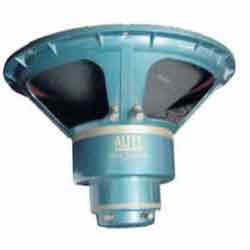 The original speaker used in the EMI studio.
The original speaker used in the EMI studio.
Introduction:
Last Friday there was an article in my newspaper about the recording history of The Beatles.
It was based on a technical book 'Recording The Beatles. The Studio Equipment and Techniques Used To Create Their Classic Albums' by Brian Kehew and Kevin Ryan. Curvebender Publishing.
It's focus is clear. It was the sixties, and many 'recording technique' was new at the time. Studios had to design and order the construction of their equipment. Many things invented in those days have survived to this day. Maybe now the actual effects are reconstructed in digital technology, but the basics remain.
There was one trick described which seems to still be used by recording studios today. Paul McCartney remarked in the EMI studios that the recordings of his bass were very cold. Especially from what he had heared in American recordings. And he had heared about a little trick he would like to try. Here a description and a little experiment with that trick!

Backgrounds:
The idea was pretty simple, yet unheared of before in England. For recording an electric bassguitar, one places a microphone in front of the bass amplifier for recording the sound. But the trick was not to use a microphone, but a loudspeaker. A loudspeaker is in fact exactly the same as a microphone. It's a moving membrane driving a coil in a magnet producing electricity. Normally a speaker works the other way around, but you can simply reverse it's functionallity. I thought it would be great to try out how that sounded.
 The original speaker used in the EMI studio.
The original speaker used in the EMI studio.
The technician in charge wired it up and it worked like a dream. It was subsequently used on all recordings. The EMI directors found it to be outrageous and even punished the technician by holding back one days' pay. McCartney payed that to the man..
For the test i used what i had at hand. I just had to buy a little audio transformer to get a proper connection to my recording deck.
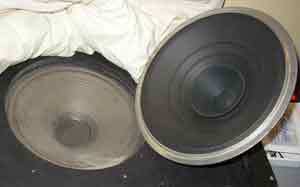 | 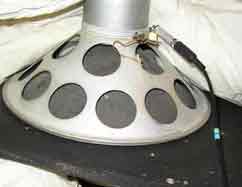 | 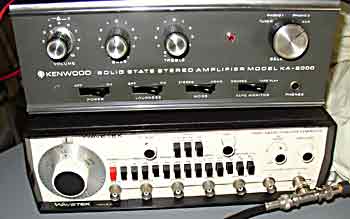 |
| Speaker speaker left, Microphone speaker right. | Now placed face to face. You can see the little yellow transformer. | Sweep generator and audio amplifier. |
The bottom speaker i connected to an audio amplifier. This got a signal from a tone generator. The tone generator produces very precise sine waves and the frequency can be set very accurately. I got a signal from the generator and the 'microphone' speaker directly to my recorder. So i had the basic sine source recorded as well as the signal passing through the amplifier, speaker and microphone speaker.
A quick listen revealed indeed a rich and 'booming' sound character. The large 12" 'microphone' speaker was far more excited about the low end then the high frequencies. As expected, because the mebrane is so heavy and large.
But more important was that it was not a direct relation. Sometimes the respons went up and down with frequency. It's all resonances. At certain frequencies the speaker vibrates naturally, like the body of a guitar.
Analysing the response.
The generator can also be set up to produce a train or sweep of frequencies. I set it to sweep from 80Hz to 500Hz and made a recording. It's just very short, but it's enough to analyse. I used MatLab to do this analysis. That's a great program that offers everything for doing frequencies analysis and making nice graphs. And here is the result of the sweep:
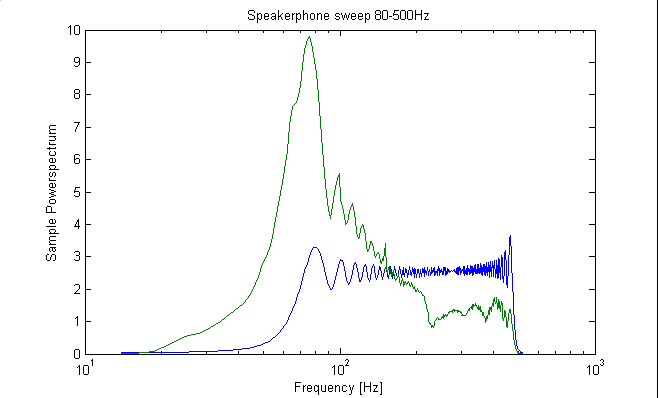
Result of the frequency sweep. Blue is the original signal, green the 'speakermicrophone' signal.
Single Sweep.mp3 is the test signal i used for the analysis. But it's just a very short 'wwooooieeep' sound.
You have to dismiss the jagged nature of the traces. That's a limitation of the analysis and the shortness of the sample which is 0.645 seconds, two channels 44100Hz and 24 bits. Longer samples give smoother results, but take far longer to calculate.
Immediately we see that there's a steep drop with frequency, with some humps here and there. And also the response picking up around 220Hz. I think it is the special construction of the 'speakermicrophone'. It's got an extra dome for producing higher frequencies, and it's probably that which starts to kick in. At first i also suspected the transformer, but that's straight all the way from 100Hz to >>60kHz. Which is quite remarkable in itself!
Now we know the cold, hard facts. But what does it sound like with a bass guitar? Tune in later for that; i think my neighbors are asleep now ;)
<back to experiments main page
poesboes 05-03-2007